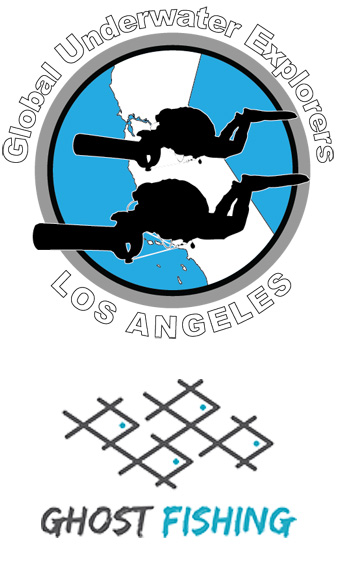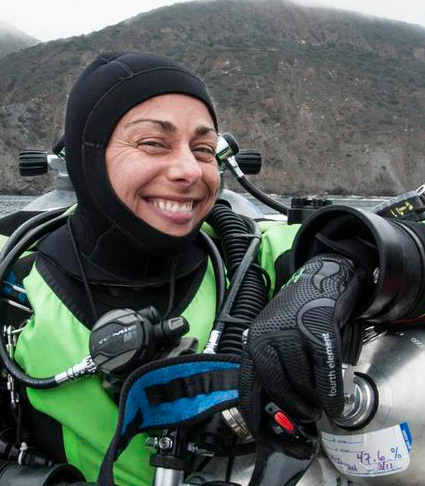 Two years ago, a group of divers from Los Angeles area (LAUE: Los Angeles Underwater Explorers) started a project to clean up the wreck of the Infidel at Catalina. Their goal was to remove all the fishing nets which covered the wreck and regularly trap marine life (seals, sea lions, and even birds). The wreck is located in 150ft of water, which makes the cleaning work challenging and requires lots of caution. Strong dive teams are a must, and it’s a very rigorous process.
Two years ago, a group of divers from Los Angeles area (LAUE: Los Angeles Underwater Explorers) started a project to clean up the wreck of the Infidel at Catalina. Their goal was to remove all the fishing nets which covered the wreck and regularly trap marine life (seals, sea lions, and even birds). The wreck is located in 150ft of water, which makes the cleaning work challenging and requires lots of caution. Strong dive teams are a must, and it’s a very rigorous process.
While the Infidel lies in only moderate technical diving depths, it’s still considered an advanced dive. The wreckage happens to be just the right distance from the island to at times have a veritable freeway overhead. Because trolling fishing boats, jet skis, charter and sightseeing boats all seem to track overhead, this is definitely not the place to surface without a down line.
The encounter of a lifetime
On Aug 23, 2014, new missions were set to both continue removing the nets (and a lot was removed again), and to document new life on the wreck. They conducted two dives – one to document the wreck in photos and on video, followed by another cleanup dive.
Heather Hamza explains: “Karim Hamza and I were on CCR. Landyn Froehlich & Cyrille Rio were on open circuit. In order to give them the best chances at decent footage, we staged the dives so that they could get photos before we started working and trashed the visibility.”
Cyrille continues: “The visibility wasn’t very good on that first dive, and we had to put a line from the mooring to the wreck. There was a lots of silt, but it was possible to circle the wreck and get some video footage of the marine life. After 30 minutes of bottom time, we headed back to the line, and just when we were leaving the wreck, Landyn saw a massive great white shark swimming around, 30-40 feet from us. He (Landyn) flashed his light and I looked back. What an excitement. The dream of every scuba diver coming true. It is so rare. That would make it a day and let us forget the poor visibility.
We looked at the great white female heading towards us, thinking she would not be staying for long, and we’d have been super happy with just a glimpse of her anyway. But just at the point we were reaching the ascent line, she started to swim toward us, getting closer and closer. Still under excitement, we set up for the ascent, but getting closer to each other than usual, and looking at the shark carefully. We started the ascent very slowly (slower than usual) and she was following us, circling around with smaller and smaller circle. The shark’s attitude was not aggressive at all. She was certainly curious about the bubble makers, and probably also wondering why these 2 sea-lion wanabees were so slow and carrying so much gear!
At that point, we had switched off our lights, and the concern was increasing a notch. Why is she staying? We’ve been dreaming of this experience, we’ve been telling people that GWS were not attacking divers, nor even human – only by mistakes when they are mistaken as sea lions or seals, which clearly we were not. Still, without shark real experience, it is difficult to fight centuries of human fear of ‘THE GWS’, hearing the JAWs theme in a corner of your head, and forgetting about all negative media coverage on sharks attacks, whatever the reasons. So there was for sure a minute and a half where we not too brave, under 130-140ft of water, knowing that we had 30min of deco in front of us and a 18ft shark getting closer and closer!
At one point, she came really close, maybe within a meter or less, and I put my camera in front of me by instinct for protection, in a way I consequently missed some outstanding footage… It would have been a shame she would have bit it (maybe I would have run after her to get the SD card back), but it would have been better than my buddy’s fin!
Too close for comfort
Karim explains “The shark got too close for comfort from our vantage point. It seemed to me that they were hanging like bait. Having encountered wild animals in the past, it is important not to behave like a prey, so I scootered toward her which surprised her and she started to make wider circles. I was trying to give an opportunity to Cyrille to get a shot of a diver and the shark so we could get a sense of perspective. She eyeballed me but did not cooperate. She started to swim away. At that moment I noticed a big rope coming out of her mouth and trailing several feet behind her, so I started to scooter after her to try to remove the rope (I knew this was stupid idea, but decided to do it anyway), but she was faster, and swam away in the direction of the Infidel wreck. Heather and I came back to the descent line, waved the documentation team off, and started our dive to remove the ghost nets from the Infidel for the next 4 hours.”
Cyrille recalls “After that intense moment, we relaxed a little bit. Obviously, she was just checking us out, her approach and attitude were slow and again not aggressive. When we reached 110ft, we met the second team on their descent, using scooter. At this point she probably got scared and left all of us.
We continued the ascent, hitting the 20 foot final decompression stop for 15 minutes where some concerns kicked in again, as we could picture her coming back from the deep! We probably used a bit more gas than usual during this ascent, but looking back, I think we stayed pretty calm from the outside. Maybe like her: she was also very calm, but with a lot of questions inside her head. Maybe she wanted us to remove the long and large line she had on her mouth?”
The shark was trailing a long line, beginning in its mouth which can be seen clearly in the video. The rope was 1-1/2 inch thick– far too big for a fishing line. Could she have ingested a float?
The encounter from a different perspective
Team 2 had a very different interaction, but still unbelievable.
According to Karim, “As we started to descend following the drop line, I notice a lot of bubbles coming up. I was wondering if someone had a major leak or free flowing regulator. We looked down, and we saw clearly the divers below us. They were just breathing hard, huffing and puffing. I noticed a fish swimming around them, then I realized it was a really big fish. As we were getting closer, I realized it was a shark, a big a$$ shark, and then it dawned on me, I yelled through my rebreather to my wife, Heather: “Heather, Heather, it’s a great white, it’s a great white”. Add the funny voice caused by the helium mixture, and then you have a very comical moment.
In any case, it was a totally awesome dive, and having real life unexpected experience with the such a wonderful animal is extremely rewarding. It put of lots of things in perspective, and the fact she was mouth-hooked with this line confirmed further that the net cleaning activities we are doing is necessary and that people should be more cautious about how they treat the Ocean and perceive marine ecosystems.
It is interesting to try to remember all what went through in your head in these moments. Was I really scared? Probably at some point, but for some reasons, the excitement was always stronger. I was constantly looking at her (missing some good footage), both to check the situation and in a survey-mode, but also completely attracted by the animal sight and fully absorbed by the experience. There was a point where some ‘we are not going to make it’ thinking was floating around, but maybe more created by the chill of the encounter, as for some reasons, I always knew I’d be able to share the experience to everyone ! So maybe the centuries of human consciousness on sharks is actually evolving positively!”
Divers aren’t for lunch – or dinner
Were the divers in serious danger, being in the presence of a large great white shark? Not according to Ralph S. Collier from the Shark Research Committee.
“The shark would never have ‘mistaken’ (the divers) for prey. White sharks have very good vision, with the same ratio of rods and cones in the retina as humans, although they do have a spectrum shift to green due to their aquatic environment. Therefore, the likelihood that it would mistake you for a pinniped, an animal that is solid from nose to hind flipper while humans are only solid from the waist up, is highly unlikely. Further, their behavior was not representative of a pinniped’s behavior. She was merely curious and made an appearance to ‘check out’ the intruders.”
After 2 years of effort, the last few months of cleanups have been very successful, to a point that more marine life is being witnessed on this wreck, with lobsters, nudibranches and even a wolf eel. The divers from the Los Angeles Underwater Explorers continue getting to the wreck to finish up the cleaning.
“And I hope we’ll see her again swimming around!”
Related Stories:
Diving The Infidel: Advanced Diving at Catalina Island
What is “technical diving”
Tech Diving: Rebreathers Offer Great Advantages to Tech Divers
All words and photos ©2014 by California Diver Magazine and the original authors/photographers. The above content may not be copied or repurposed without prior express permission.

